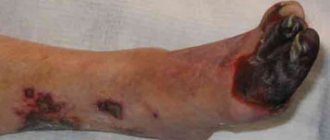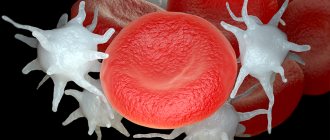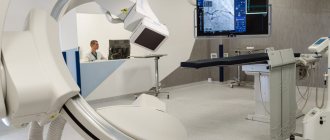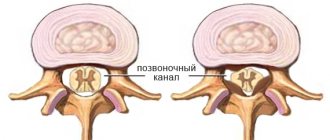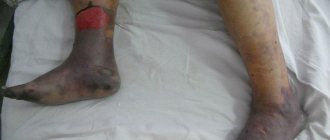All doctors unanimously recognize this type of disease as one of the most serious. Of all forms of stenosis, damage to the cervical canal is the most dangerous. This condition is a chronic pathology in which the lumen in the center of the spinal canal is narrowed due to various structural formations that are foreign. This may be a tumor or herniation, tissue protruding after a fracture, or osteophyte or age-related changes in tissue. The result is the same - the canal has too narrow a lumen, and this is fraught with multiple complications, as a result of which mobility may be lost and disability acquired.
Cervical spinal canal stenosis
How does stenosis occur?
As a rule, the pathology is diagnosed in patients after 55 years of age. Men and women suffer from it equally. Stenosis can be located throughout the spinal column. Damage to the cervical area is statistically observed in a quarter of patients with this diagnosis.
Stenosis or narrowing of the spinal canal develops as a result of degenerative changes in the spine and the natural processes of wear and tear and aging of the body.
As is known, the spinal canal contains the main pathways of the spinal cord with all its lateral branches.
Spinal cord pathways
When the space available to the brain shrinks, the pressure on it increases. Pain occurs and the impulse from the brain stops passing. Because of this, without receiving “commands,” they reduce the sensitivity of parts of the body, even to the point of stopping functioning.
Why does the spatial part of the canal located in the spinal cavity decrease?
By the way. If we are talking about age-related reasons, then after sixty the neck, which has many large vessels through which the brain tissue is supplied with nutrition, ceases to function normally. In it, changes in structures are outlined and carried out, putting pressure on the venous and arterial ducts. The duct channels narrow, causing disruption of blood flow. This is stenosis.
With this disease, which affects middle-aged people, the cervical canal is closed by deformed vertebral segments, formations, and other mechanical causes.
There are a number of factors that contribute to the appearance and spread of stenosis.
What's happened
First, it’s worth understanding what a carotid artery is: in the human body there are two carotid arteries, running from the chest through the sides of the neck to the head. Their main task is to nourish the brain. Like any artery, they are confirmed by atherosclerosis - a serious disease, the nature of which is not fully understood, as well as the causes. This disease manifests itself in the deformation of the walls of blood vessels, when the tissues lining the vessel grow, cholesterol deposits appear between them, and the lumen of the vessel becomes smaller and smaller until it becomes completely blocked (obstruction). Oxygen-enriched blood flows through the carotid arteries for brain cells, so narrowing the lumen of the vessel is very dangerous - it can cause a stroke.
Causes of the disease
To identify possible causes, it is necessary to first classify the disease into several types. There is congenital and acquired stenosis. Their reasons, of course, are different.
Congenital pathology
In turn, there are two types: lateral and central. In the first variant, the space in which the branches of the cerebral roots are located is narrowed (its other name is lateral).
In the second, the central canal is narrowed to a significant reduction in its volume.
Possible complications if left untreated
Without timely and adequate treatment, absolute stenosis can have extremely serious consequences. And irreversible paralysis of the limbs is far from the only thing. Thus, due to impaired nutrition of spinal cord cells and deterioration of its oxygen supply, an ischemic stroke of the spinal cord may occur. And if the spinal canal is critically narrowed at the level of the thoracic or cervical region, death may occur due to respiratory distress or sudden cardiac arrest.
Classification of stenosis
The disease can be divided into three groups according to causative factors.
- Hereditary stenosis, designated as congenital, is so named not because, like many hereditary pathologies, it begins to develop in the womb, but because its development occurs due to the presence of congenital diseases of the spine.
- Degenerative stenosis is considered acquired. It begins its development with the onset of destructive and degenerative changes that occur as a result of diseases or injuries.
- Combined stenosis is of a mixed type and combines both congenital and acquired causes.
Degenerative stenosis is a consequence of the natural aging process of the spine
As already noted, stenosis is classified anatomically into two types.
- One of them is central, which results in a loss of canal volume, that is, a reduction in the distance between the side walls, either back and front, or radial narrowing.
- The lateral, called lateral, states a decrease in the volume of the passages into which the branches of the spinal roots go.
Treatment of carotid artery stenosis
The most common treatment for stenosis is artery stenting. Stenting is a surgical treatment method, therefore, like any other surgical intervention, it requires a highly qualified doctor in diagnosis, deciding on the need/possibility of surgery and direct insertion of the stent. A stent is a metal frame inserted directly into an artery. At the point of narrowing, it unfolds and expands the walls of the vessel as necessary. The stent remains in the artery. Only in the first days its presence can be inconvenient due to changes in blood flow, but over time the patient stops feeling it and returns to normal life without the risk of a stroke. But of course, the doctor will give certain recommendations for further lifestyle in order to prevent re-stenosis.
Our doctors understand the importance of high-quality patient management and postoperative monitoring, so by contacting us, you can count on an integrated approach to diagnosis, treatment and the postoperative period. To implement this approach, the neurology department of the Federal Scientific Research Center has a powerful diagnostic base and a strong team of specialists with extensive experience in the treatment of stenosis, who additionally undergo advanced training courses on a regular basis. The department closely cooperates with the cardiac surgery service and the department of vascular surgery, which is separated into a separate unit.
The advantage of our center is the provision of a full range of services to our patients in one place, starting with an initial consultation, which you can sign up for by phone or through a special form on the website.
Diagnostics
Obviously, with the earliest possible diagnosis, the possibility of eradicating the disease is much greater. In addition, this will help to avoid serious pathological situations.
The disease is diagnosed using a number of special methods.
Table. Methods for diagnosing stenosis.
| Way | Description |
| It consists of interviewing the patient, visual examination of the cervical area, and palpation of this area. An attempt is made to identify all existing symptoms. |
| The mandatory next step is to take two photographs – a side view and a front view. Using the results obtained, it is possible to determine the degree of integrity of the vertebral segments and the presence of foreign formations. |
| Myelogram | A very important stage of a detailed examination, which consists of performing fluoroscopy, but with contrast injected into the spinal area. This substance will show the structure of the canal, help determine the volume of cerebrospinal fluid in it, and also determine the patency of the canal. |
| This method is informative and can detect the slightest changes in the spinal segments and canal. When performing layer-by-layer scanning, information about the causes of stenosis becomes available to doctors. |
| The best and highly informative diagnostic method that allows you to recognize stenosis in the early stages. It will show changes in the vertebrae, blood vessels, discs, cartilage, bone and periosteal tissue, and damage to nerve endings. |
After a thorough and comprehensive diagnosis, the doctor immediately begins treatment, which is always characterized by an integrated approach and is individualized.
If you want to learn in more detail how to treat spinal stenosis in the lumbar region, and also consider alternative treatment methods, you can read an article about this on our portal.
Symptoms
Depending on which vessels are affected, the symptoms of arterial stenosis vary.
- If stenotic processes occur in the vessels of the heart, exertional angina appears - we wrote about its functional classes earlier. The reason to seek emergency help in this case may be a prolonged attack (more than 15 minutes), which does not stop at rest or when taking the usual dose of nitroglycerin. Such signs usually indicate acute coronary syndrome.
- Stenosis of the vessels responsible for the blood supply to the brain is no less dangerous, as it can lead to cerebral infarction or stroke. Carotid artery stenosis is a dangerous phenomenon, the consequence of which is often fatal.
- Stenoses can also occur in peripheral vessels, including the arteries of the lower extremities. Common symptoms of atherosclerosis of the lower extremities are pain in the legs when walking or at rest, periodic lameness, and discoloration of the skin. Stenotic processes in this vascular bed lead to ischemia of the lower extremities, which in the absence of timely treatment can lead to disability.
Surgery for spinal stenosis
Doctors at the Pirogov Clinic treat degenerative stenoses both conservatively and surgically. All spine surgeries are performed using the latest endoscopic or microsurgical technology, as well as X-ray or radiofrequency equipment.
In most cases, preference is given to endoscopic operations for spinal stenosis
. They allow you to avoid the installation of implants - with the exception of cervical stenosis and cases where spondylolisthesis and instability of the spinal segment are also observed. In addition, such operations are characterized by maximum controllability, minimal risks, and for patients, rapid recovery after endoscopic surgery for spinal stenosis is tolerated most comfortably. The pain in the legs goes away immediately after the operation, and hospitalization in the clinic is only 1 day.
Find out more about endoscopic spine surgeries.
Stenosis surgery performed using microsurgical method
, also refers to minimally traumatic interventions. It is advisable (and may even be the only solution) if, along with expansion of the spinal canal and decompression of the spinal roots, stabilization of the spinal segment is necessary. Such operations show good clinical results and, unlike traditional open spinal surgeries, allow the patient to recover quickly and avoid the risk of disability.
Unfortunately, sometimes it is impossible to do without the installation of metal structures and endoscopic surgery is impossible. A difficult case from the practice of neurosurgeon Mereja Amir Muratovich
. The patient developed stenosis complicated by spondylolisthesis due to displacement of the vertebrae, which caused acute compression of the roots of the spinal canal. To avoid destabilization of the L4-L5 spinal segment and avoid severe consequences in the future, it was decided to fix the segment with screws and install an interbody cage. The operation was performed with pinpoint precision—the pain and weakness in the patient’s legs disappeared immediately after the intervention. The case was difficult and exceptional, but thanks to the experience and skill of our specialists, the patient was able to recover within 1 day.
Find out more about microsurgical operations on the spine.


